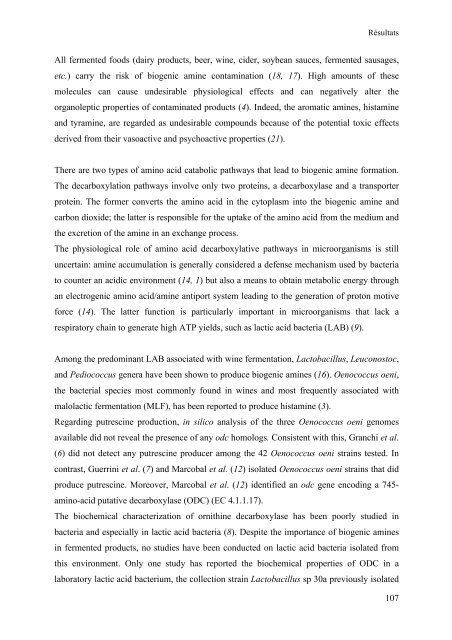THESE Maryse Bonnin Jusserand - Université de Bourgogne
THESE Maryse Bonnin Jusserand - Université de Bourgogne
THESE Maryse Bonnin Jusserand - Université de Bourgogne
Create successful ePaper yourself
Turn your PDF publications into a flip-book with our unique Google optimized e-Paper software.
Résultats<br />
All fermented foods (dairy products, beer, wine, ci<strong>de</strong>r, soybean sauces, fermented sausages,<br />
etc.) carry the risk of biogenic amine contamination (18, 17). High amounts of these<br />
molecules can cause un<strong>de</strong>sirable physiological effects and can negatively alter the<br />
organoleptic properties of contaminated products (4). In<strong>de</strong>ed, the aromatic amines, histamine<br />
and tyramine, are regar<strong>de</strong>d as un<strong>de</strong>sirable compounds because of the potential toxic effects<br />
<strong>de</strong>rived from their vasoactive and psychoactive properties (21).<br />
There are two types of amino acid catabolic pathways that lead to biogenic amine formation.<br />
The <strong>de</strong>carboxylation pathways involve only two proteins, a <strong>de</strong>carboxylase and a transporter<br />
protein. The former converts the amino acid in the cytoplasm into the biogenic amine and<br />
carbon dioxi<strong>de</strong>; the latter is responsible for the uptake of the amino acid from the medium and<br />
the excretion of the amine in an exchange process.<br />
The physiological role of amino acid <strong>de</strong>carboxylative pathways in microorganisms is still<br />
uncertain: amine accumulation is generally consi<strong>de</strong>red a <strong>de</strong>fense mechanism used by bacteria<br />
to counter an acidic environment (14, 1) but also a means to obtain metabolic energy through<br />
an electrogenic amino acid/amine antiport system leading to the generation of proton motive<br />
force (14). The latter function is particularly important in microorganisms that lack a<br />
respiratory chain to generate high ATP yields, such as lactic acid bacteria (LAB) (9).<br />
Among the predominant LAB associated with wine fermentation, Lactobacillus, Leuconostoc,<br />
and Pediococcus genera have been shown to produce biogenic amines (16). Oenococcus oeni,<br />
the bacterial species most commonly found in wines and most frequently associated with<br />
malolactic fermentation (MLF), has been reported to produce histamine (3).<br />
Regarding putrescine production, in silico analysis of the three Oenococcus oeni genomes<br />
available did not reveal the presence of any odc homologs. Consistent with this, Granchi et al.<br />
(6) did not <strong>de</strong>tect any putrescine producer among the 42 Oenococcus oeni strains tested. In<br />
contrast, Guerrini et al. (7) and Marcobal et al. (12) isolated Oenococcus oeni strains that did<br />
produce putrescine. Moreover, Marcobal et al. (12) i<strong>de</strong>ntified an odc gene encoding a 745-<br />
amino-acid putative <strong>de</strong>carboxylase (ODC) (EC 4.1.1.17).<br />
The biochemical characterization of ornithine <strong>de</strong>carboxylase has been poorly studied in<br />
bacteria and especially in lactic acid bacteria (8). Despite the importance of biogenic amines<br />
in fermented products, no studies have been conducted on lactic acid bacteria isolated from<br />
this environment. Only one study has reported the biochemical properties of ODC in a<br />
laboratory lactic acid bacterium, the collection strain Lactobacillus sp 30a previously isolated<br />
107

















